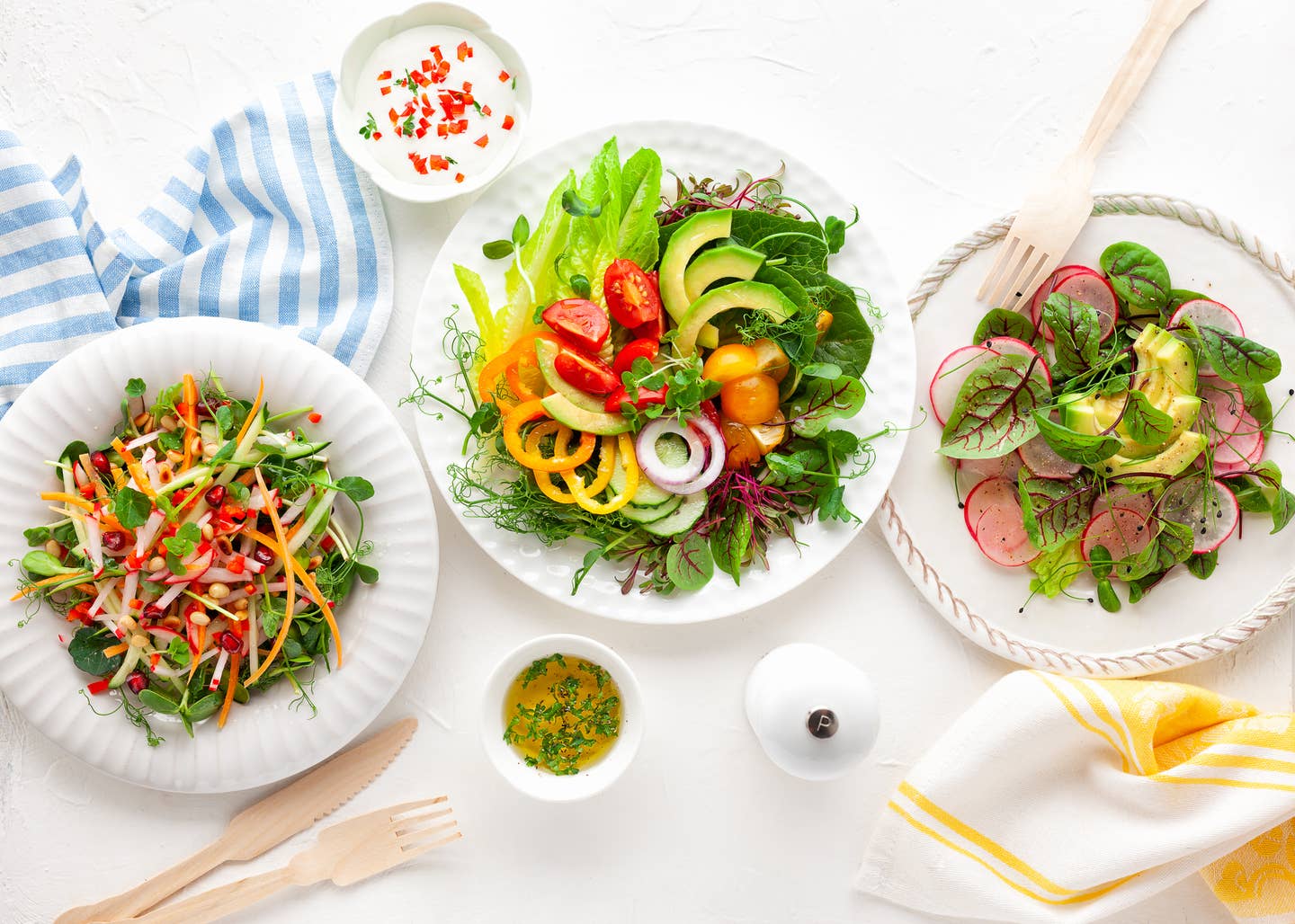
The Top 10 Sources of Plant-Based Protein, According to a Nutritionist
As a nutritionist, I hear a lot about protein. In fact, the number one reason people tell me they are reluctant to eat a fully plant-based diet is the worry that they won't get enough protein. The second biggest reason they give is: They don't want to miss out on their favorite foods, such as meat or cheese. Now that Beyond Meat and Impossible Burgers are taking the nation by storm, and you can find a decent selection of nut-cheeses at any Whole Foods, the remaining sticking point is the question of "How do I get enough protein?" But eating plant-based protein sources shouldn't be a reason to not try eating this way.
In fact, some good news: High protein vegan foods are pretty easy to come by, and you’re probably already getting plenty right now, without even trying.
That’s because protein recommendations (whether you’re following a plant-based diet or not) aren’t all that high. The Recommended Dietary Allowance (RDA) for protein is 0.8
grams per kilogram of body weight or 0.36 grams per pound of body weight. For a 150-
pound person, that’s about 54 grams of protein per day. Very active people need a bit more to help with muscle growth and recovery. Most recommendations suggest eating around 1.2 to 2.0 grams of protein per kilogram or 0.5 to 0.9 grams per pound. For that same 150-pound person, that’s about 75 to 135 grams of protein each day.
These numbers can seem a bit arbitrary, but they're easier to hit than you think if you focus on adding a few high-protein vegan foods to your plate. To help you get there, we compiled a list of some of the top plant-based protein sources. With a combination of these foods, you’ll see how easy it is to meet your daily protein needs on a plant-based diet and do it deliciously.
10 Vegan Foods High in Protein
1. Seitan
Protein: 21 grams in ⅓ cup (1 ounce)
Seitan isn’t as popular as other proteins, but it should be! Made from wheat gluten, its texture resembles ground meat. It’s often used in pre-made veggie burgers or meatless nuggets. Seitan has a savory taste, like mushrooms or chicken, so it works well in dishes that call for an umami flavor.
With a hearty texture, seitan can be the star of practically any vegan main dish. Add it to stir-fries, sandwiches, burritos, burgers, or stews. Like tofu, seitan will take on the flavor of any marinade or sauce.
2. Tempeh
Protein: 16 grams in 3 ounces
If you like a protein with a bit of bite, add tempeh to your list. Made from fermented soybeans, tempeh has a slightly nutty flavor and is pressed into a block. Most varieties include some sort of grains, such as barley or millet. Not only is tempeh a plant-based source of protein, but the fermentation process also creates good-for-your-gut probiotics. You can cut tempeh right off the block and use it as the base for a sandwich or pan-fry it with some sauce. Or, crumble, heat, and make it the star of your next taco night.
3. Lentils
Protein: 13 grams in ½ cup cooked
Lentils come in multiple varieties--red, yellow, green, brown, black. Regardless of the type lentils are small but mighty nutritional powerhouses. They pack a good amount of protein as well as iron, folate, and fiber. When cooked, brown lentils retain their texture and can be the base for a grain bowl or make a hearty substitute for ground meat in meatballs, lasagna, tacos or Bolognese. Red lentils are a bit softer and make a nice add-in for a hearty soup, chili, or stew.
4. Hemp seeds
Protein: 10 grams in 3 tablespoons
Hemp seeds are a tender and nutty seed, derived from the hemp plant. They contain good amounts of omega-3s, iron, folate, magnesium, phosphorus, and manganese. They are also a solid source of both soluble and insoluble fiber, which helps to keep your digestive tract healthy and humming.
Because they pack a double whammy of protein and healthy fats, hemp seeds can help satisfy hunger, preventing those embarrassing stomach growls as you slog your way to your lunch break. Add them to your morning smoothie or sprinkle them on top of yogurt, oatmeal, or even a salad.
5. Tofu
Protein: 9 grams in 3 ounces (⅕ of a block)
Made from coagulated soybeans, tofu is the most popular plant-based protein. Soy is one of the only meatless "complete" proteins, meaning that it contains all of the essential amino acids that the body can’t make but needs for muscle and immune function. With 15 percent of your daily calcium needs, tofu is also a good replacement for dairy. Tofu is versatile, affordable, easy to prepare and it comes in a variety of forms. For some quick and easy cooking ideas, try these tips (just remember to drain the tofu first for 30 minutes if you want it firm, as most tofu contains excess water):
- Coat extra firm tofu in olive oil and bake in the oven at 400°F for 15 minutes or until it becomes crispy.
- Add firm tofu to stir-fries or soups.
- Blend silken tofu into smoothies, sauces, and dressings. (You won’t need to drain the tofu for this.)
6. Edamame
Protein: 9 grams of protein in ½ cup
This sushi appetizer is a nutrient powerhouse, so eat it anytime. Edamame is really just another name for soybeans in their pods. Let’s list off some stats – a small ½-cup serving of edamame has 9 grams of protein, 15 percent of your daily vitamin C, 10 percent of your daily iron, and 16 percent of your daily fiber.
Keep a bag of edamame in your freezer to serve as a fun-to-eat side dish or opt for the shelled variety to toss into salads or a grain bowl.
7. Quinoa
Protein: 8 grams per cup (cooked)
This non-grass grain cooks up just like brown rice (boil 1 parts gran, 2 parts water) but quinoa is as versatile as any food can be. It works as a savory starch in salads or with dinner, or as a cereal substitute with oat milk and fruit in your morning breakfast bowl. Quinoa contains healthy micro-nutrients like manganese, phosphorus, magnesium, fiber, folate, and zinc.
Quinoa is an ancient grain and since it's gluten-free a great choice for anyone avoiding gluten. Add it to your burger recipe to create a filling texture, or instead of meat in your taco or burrito. Quinoa is among the healthiest foods on the planet, delivering phytonutrients that have anti-inflammatory qualities, so keep it in your pantry for any meal that needs a filling grain. Just remember to soak it and rinse it before cooking to get rid of any bitter taste.
8. Black Beans
Protein: 7 grams in ½ cup (canned)
Eating beans on the regular might as well be a prerequisite for a plant-based diet. Not only are canned black beans inexpensive, but they also contribute 10 percent of your daily iron and 25 percent of your daily fiber to your diet. For less than $1 a can, beans can be the star of tacos, quesadillas, salads, soups, burgers, or dips.
9. Amaranth
Protein: 6 grams in ⅔ cup (cooked)
Chances are you’ve never cooked amaranth. But you should, since this tiny, gluten-
free grain is packed with almost 30 percent of your daily fiber and 20 percent of your daily iron. Cook it like a traditional grain to yield a soft, porridge-like texture. Many people add amaranth to other a hot breakfast cereal mixture, like oats and quinoa. It also pops like popcorn. Toss it in a pot with some oil and wait for it to pop up into a nutritious snack.
For more great sources of protein, check out The Beet's Top 20 Vegetables that Pack the Most Protein Per Serving, And don't miss The Beet's stories on Best Legumes with the HIghest Protein, Best Nuts with the Most Protein and Best Seeds with the Most Protein. You won't believe how much protein broccoli has!
10.Peas
Protein: 5 grams in ⅔ cup
If peas were one of your most hated veggies as a kid, it’s time to give them another chance. These green beans are a great low-calorie protein to keep in your freezer.
Sure, they don’t always taste great when steamed or microwaved (who wants to eat mushy, overcooked peas?), but they do blend well into a yummy puree that can be slathered on toast. To amp up the flavor, add some lemon juice or mint to your mix before you blend.
More From The Beet






